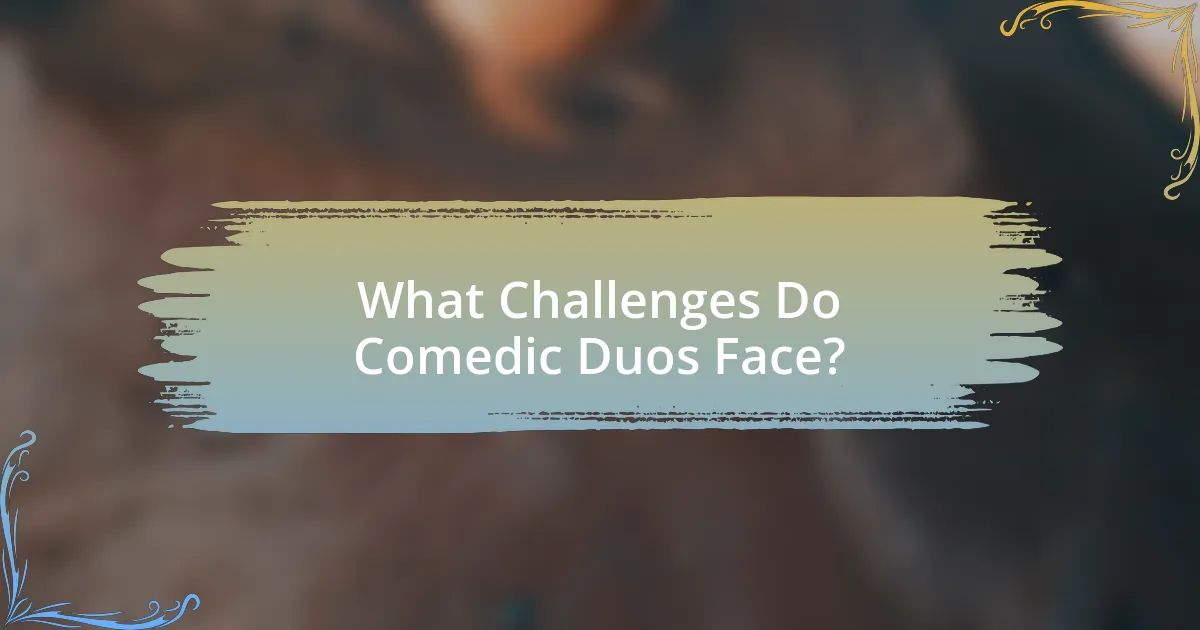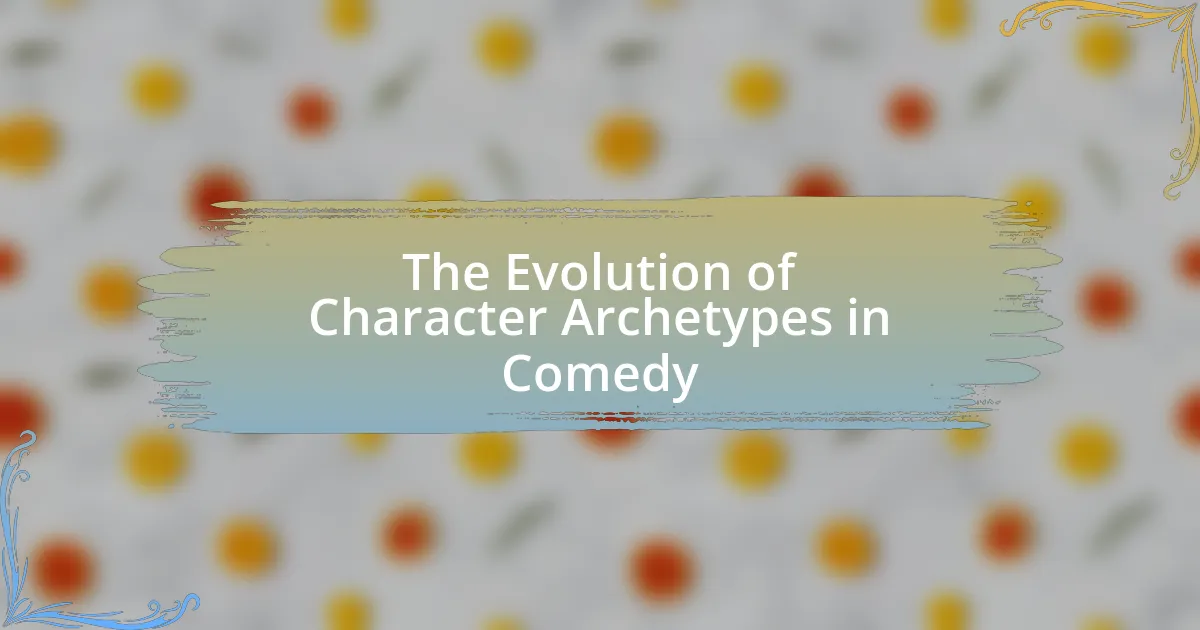Iconic comedic duos are pairs of comedians or actors whose collaboration results in memorable and influential comedic performances, exemplified by partnerships like Abbott and Costello and Laurel and Hardy. This article analyzes the defining characteristics of these duos, including their chemistry, contrasting styles, and the historical context that shapes their humor. It explores how their dynamics resonate with audiences, the evolution of comedic styles over time, and the challenges they face in maintaining their partnerships. Additionally, it highlights the role of media in amplifying their impact and offers insights for aspiring comedic duos on best practices for success.
![]()
What are Iconic Comedic Duos?
Iconic comedic duos are pairs of comedians or actors who collaborate to create memorable and influential comedic performances. Examples include Abbott and Costello, known for their classic routines and films in the mid-20th century, and Laurel and Hardy, who became famous for their slapstick humor and unique character dynamics. These duos often rely on contrasting personalities, timing, and chemistry to enhance their comedic impact, making them enduring figures in entertainment history. Their collaborations have shaped the landscape of comedy, influencing countless performers and genres.
How do we define an iconic comedic duo?
An iconic comedic duo is defined as a pair of performers whose chemistry, contrasting styles, and shared comedic timing create memorable and influential comedic moments. This definition is supported by the historical success of pairs like Abbott and Costello, whose routines became cultural touchstones, demonstrating how their unique dynamics resonated with audiences and shaped the landscape of comedy. Their ability to complement each other’s strengths while providing contrasting comedic perspectives exemplifies the characteristics that make a duo iconic.
What characteristics distinguish iconic duos from others?
Iconic duos are distinguished by their complementary dynamics, unique chemistry, and memorable interactions. These pairs often exhibit a balance of contrasting personalities, such as the straight man and the comic relief, which enhances comedic timing and audience engagement. For example, the partnership of Abbott and Costello showcases this dynamic, where Abbott’s straight-laced demeanor contrasts with Costello’s bumbling antics, creating a classic comedic formula. Additionally, iconic duos often share a deep understanding and mutual respect, allowing for seamless collaboration and improvisation, as seen in the relationship between Tina Fey and Amy Poehler. Their ability to play off each other’s strengths and weaknesses solidifies their status as memorable comedic pairs.
Why do certain duos resonate more with audiences?
Certain duos resonate more with audiences due to their complementary dynamics and relatable chemistry. This synergy often creates a balance between contrasting personalities, which enhances comedic timing and emotional engagement. For example, the pairing of a straight man with a comedic foil, as seen in classic duos like Abbott and Costello, allows for a dynamic interplay that amplifies humor. Research indicates that audiences are drawn to duos that exhibit strong interpersonal connections, as these relationships foster a sense of authenticity and relatability, making the content more engaging.
What historical context surrounds iconic comedic duos?
Iconic comedic duos often emerge from specific historical contexts that shape their humor and appeal. For instance, during the early 20th century, vaudeville and silent film eras fostered partnerships like Laurel and Hardy, whose slapstick comedy resonated with audiences facing the hardships of the Great Depression. Similarly, the post-World War II era saw the rise of television, allowing duos like Lucy and Desi to reach wider audiences, reflecting societal changes and the evolving family dynamics of the time. These partnerships not only entertained but also provided social commentary, often addressing contemporary issues through humor, thus solidifying their place in cultural history.
How have comedic duos evolved over time?
Comedic duos have evolved significantly over time, transitioning from vaudeville and radio acts to modern television and film partnerships. Early duos, such as Laurel and Hardy, relied heavily on physical comedy and slapstick, while later pairs like Abbott and Costello introduced more verbal wit and timing. In recent decades, comedic duos have embraced diverse styles, incorporating elements of improvisation and social commentary, as seen in the collaborations of Tina Fey and Amy Poehler or Key and Peele. This evolution reflects broader societal changes and audience preferences, showcasing a shift from simple humor to more complex narratives that often address contemporary issues.
What role has media played in shaping these duos?
Media has played a crucial role in shaping iconic comedic duos by providing a platform for their visibility and popularity. Through television shows, films, and social media, these duos have been able to reach wide audiences, allowing their comedic styles and chemistry to resonate with viewers. For instance, shows like “Saturday Night Live” and films such as “Dumb and Dumber” have not only showcased the talents of duos like Tina Fey and Amy Poehler or Jim Carrey and Jeff Daniels but have also contributed to their cultural significance and legacy in comedy. The media’s ability to amplify their performances and create memorable moments has solidified their status as iconic pairs in the entertainment industry.
What are some examples of iconic comedic duos?
Some examples of iconic comedic duos include Abbott and Costello, Laurel and Hardy, and Cheech and Chong. Abbott and Costello, active from the 1930s to the 1950s, are known for their classic “Who’s on First?” routine, which showcases their timing and wordplay. Laurel and Hardy, a duo from the silent film era into the 1950s, are celebrated for their slapstick humor and contrasting personalities, with Stan Laurel as the bumbling fool and Oliver Hardy as the pompous foil. Cheech and Chong, prominent in the 1970s and 1980s, gained fame for their stoner comedy and cultural commentary, particularly in films like “Up in Smoke.” These duos have left a lasting impact on comedy through their unique styles and memorable performances.
What makes the pairing of [specific duo] significant?
It is not possible to answer the question as it lacks a specific duo to analyze. Without identifying the duo, I cannot provide a concrete answer regarding their significance.
How do different duos compare in terms of style and impact?
Different comedic duos compare in terms of style and impact primarily through their unique dynamics and the cultural resonance of their humor. For instance, the pairing of Abbott and Costello is characterized by their classic “Who’s on First?” routine, which exemplifies wordplay and timing, leading to a significant influence on the structure of modern comedy. In contrast, the duo of Key and Peele employs a blend of social commentary and character-driven sketches, addressing contemporary issues while maintaining a comedic tone, which has reshaped the landscape of sketch comedy. The impact of these duos can be measured by their lasting popularity and the way they have inspired subsequent generations of comedians, with Abbott and Costello paving the way for slapstick and verbal humor, while Key and Peele have opened avenues for more nuanced, socially aware comedy.

What Elements Contribute to the Success of Comedic Duos?
The success of comedic duos is primarily attributed to their chemistry, timing, and complementary styles. Chemistry between the duo fosters a natural rapport that enhances their comedic delivery, making interactions feel authentic and engaging. Timing is crucial, as effective comedic timing can elevate a joke or scenario, ensuring that punchlines land with maximum impact. Complementary styles, where one partner’s strengths balance the other’s weaknesses, create a dynamic that keeps the audience entertained. For instance, the contrasting personalities of Abbott and Costello exemplify how differing comedic approaches can work harmoniously, leading to memorable performances.
How does chemistry between duo members enhance their comedy?
Chemistry between duo members enhances their comedy by creating a seamless interaction that amplifies humor through timing, shared understanding, and complementary styles. This dynamic allows for quick exchanges and improvisation, which are essential in comedic performances. For instance, iconic duos like Abbott and Costello utilized their contrasting personalities—Costello’s straight man and Abbott’s witty responses—to create memorable routines, demonstrating how their chemistry led to comedic timing that resonated with audiences. Research in psychology indicates that effective comedic duos often exhibit high levels of rapport, which fosters an environment where humor can thrive, as seen in the successful collaborations of many comedic pairs throughout history.
What are the signs of strong comedic chemistry?
Strong comedic chemistry is characterized by seamless timing, mutual understanding, and the ability to play off each other’s strengths. This dynamic often manifests in quick-witted banter, where each participant anticipates the other’s responses, creating a rhythm that enhances humor. Additionally, shared comedic styles and complementary personalities contribute to this chemistry, allowing for a natural flow of jokes and reactions. Research indicates that successful comedic duos, such as Abbott and Costello, exemplify these traits through their iconic “Who’s on First?” routine, which showcases their impeccable timing and mutual reliance on each other’s comedic instincts.
How does timing play a role in their performances?
Timing is crucial in the performances of comedic duos as it enhances the delivery of punchlines and the overall comedic rhythm. Effective timing allows for the buildup of anticipation, leading to a more impactful joke or comedic moment. For instance, studies in comedy suggest that a well-timed pause can amplify laughter by creating suspense, as seen in the performances of iconic duos like Abbott and Costello, who expertly utilized timing to maximize audience engagement. This precision in timing not only contributes to the humor but also establishes a dynamic interplay between the performers, making their interactions more engaging and memorable.
What types of humor do iconic duos typically employ?
Iconic duos typically employ a variety of humor types, including slapstick, wordplay, and situational comedy. Slapstick humor often involves physical comedy and exaggerated actions, as seen in the routines of Laurel and Hardy. Wordplay, characterized by puns and clever dialogue, is frequently utilized by duos like Abbott and Costello, particularly in their famous “Who’s on First?” routine. Situational comedy arises from the characters’ interactions and the absurdity of their circumstances, exemplified by the dynamic between Chandler and Joey in “Friends.” These humor types contribute to the duos’ appeal and effectiveness in engaging audiences.
How do different comedic styles appeal to various audiences?
Different comedic styles appeal to various audiences by aligning with cultural backgrounds, personal experiences, and social contexts. For instance, slapstick humor often resonates with younger audiences due to its visual nature and physical comedy, while satirical humor tends to attract more mature viewers who appreciate nuanced commentary on societal issues. Research indicates that humor preferences can be influenced by demographic factors such as age, gender, and cultural identity, with studies showing that individuals from collectivist cultures may prefer humor that emphasizes group cohesion, whereas those from individualistic cultures might favor humor that highlights personal achievement. This alignment between comedic style and audience characteristics enhances relatability and engagement, making the humor more effective.
What are the common themes found in their humor?
Common themes found in the humor of iconic comedic duos include absurdity, irony, and social commentary. Absurdity often manifests through exaggerated situations or characters, creating humor from the unexpected, as seen in the works of duos like Abbott and Costello. Irony plays a significant role, where the humor arises from contradictions between expectations and reality, exemplified by the comedic timing of Laurel and Hardy. Social commentary is also prevalent, as many duos use humor to critique societal norms and behaviors, a technique effectively employed by the likes of Key and Peele. These themes resonate with audiences, making the humor relatable and impactful.
Why is audience connection crucial for comedic duos?
Audience connection is crucial for comedic duos because it enhances the effectiveness of their humor and fosters a shared experience. When comedic duos resonate with their audience, they create an environment where jokes land more effectively, leading to increased laughter and engagement. Research indicates that humor is often more impactful when it is relatable; for instance, a study published in the Journal of Personality and Social Psychology found that shared experiences significantly boost the enjoyment of comedic content. This connection allows comedic duos to build rapport, making their performances more memorable and enjoyable for the audience.
How do duos build rapport with their audience?
Duos build rapport with their audience by establishing a connection through shared humor, chemistry, and relatable content. This connection is often enhanced by their ability to play off each other’s strengths, creating a dynamic that resonates with viewers. For instance, iconic comedic duos like Abbott and Costello or Key and Peele utilize timing and complementary personalities to engage audiences effectively. Research indicates that humor fosters social bonds, making audiences feel more connected to the performers, which is crucial for building rapport.
What techniques do they use to engage viewers emotionally?
Comedic duos engage viewers emotionally through techniques such as relatable humor, character dynamics, and storytelling. Relatable humor connects with audiences by reflecting shared experiences or societal norms, making the content more accessible and engaging. Character dynamics, including contrasting personalities or complementary traits, create tension and resolution that evoke laughter and empathy. Storytelling, often involving personal journeys or conflicts, allows viewers to invest emotionally in the characters’ outcomes. These techniques are effective because they tap into universal emotions, fostering a deeper connection with the audience.

What Challenges Do Comedic Duos Face?
Comedic duos face several challenges, including maintaining chemistry, balancing creative input, and managing public perception. The chemistry between partners is crucial; if it falters, the comedic dynamic can suffer, leading to a decline in audience engagement. Balancing creative input is another significant challenge, as differing comedic styles or ideas can create tension, potentially resulting in conflicts that affect performance quality. Additionally, public perception can be a double-edged sword; while a duo may enjoy popularity, they also face scrutiny and expectations that can pressure their collaborative efforts. These challenges are evident in the histories of many successful comedic pairs, such as Abbott and Costello, who navigated creative differences while maintaining their iconic status.
How do personal dynamics affect the performance of comedic duos?
Personal dynamics significantly influence the performance of comedic duos by shaping their chemistry, timing, and overall comedic effectiveness. When members of a duo share a strong personal connection, it often leads to enhanced rapport, allowing for better improvisation and a more seamless exchange of comedic ideas. For instance, the successful partnership of Abbott and Costello exemplifies how their personal friendship contributed to their iconic routines, as their mutual understanding of each other’s comedic styles allowed for precise timing and delivery. Research indicates that effective communication and emotional intelligence between duo members can enhance audience engagement, as seen in the performances of duos like Key and Peele, where their personal dynamics fostered relatable humor and social commentary.
What are common conflicts that arise between duo members?
Common conflicts that arise between duo members include differences in creative vision, unequal contribution, and personality clashes. Creative vision conflicts occur when each member has distinct ideas about the direction of their work, leading to disagreements on content and style. Unequal contribution can create resentment if one member feels they are doing more work than the other, which can disrupt collaboration. Personality clashes often arise from differing temperaments or work ethics, causing friction in communication and teamwork. These conflicts are frequently documented in studies of collaborative dynamics, highlighting the importance of clear communication and mutual respect in maintaining a successful partnership.
How can these conflicts impact their comedic effectiveness?
Conflicts can enhance comedic effectiveness by creating tension that leads to humorous situations. When comedic duos experience disagreements or contrasting personalities, it generates a dynamic interplay that can result in witty banter, misunderstandings, and situational comedy. For instance, the classic conflict between a straight man and a comic foil often amplifies the humor, as seen in the routines of Abbott and Costello, where their differing perspectives lead to iconic comedic exchanges. This tension not only engages the audience but also allows for the exploration of relatable themes, making the humor more impactful and memorable.
What external factors influence the longevity of comedic duos?
External factors that influence the longevity of comedic duos include audience reception, cultural relevance, and industry dynamics. Audience reception is critical; for example, duos like Abbott and Costello thrived during the 1940s due to their ability to resonate with the comedic tastes of the time. Cultural relevance also plays a significant role, as comedic duos must adapt to changing societal norms and values, which can be seen in the evolution of duos like Key and Peele, who address contemporary social issues. Additionally, industry dynamics, such as the availability of platforms for performance and the impact of media trends, affect how long duos can maintain their popularity; for instance, the rise of streaming services has allowed duos like The Lonely Island to reach wider audiences.
How do changing societal norms affect their humor?
Changing societal norms significantly influence humor by altering what is considered acceptable or funny. As societal values evolve, comedic content must adapt to avoid offending audiences or crossing boundaries. For instance, humor that relies on stereotypes or outdated social constructs may become less popular as awareness of social issues increases. This shift is evident in the transition from slapstick comedy to more nuanced forms of humor that address contemporary topics like diversity and inclusion. Comedians who successfully navigate these changes often find greater resonance with audiences, as seen in the rise of comedians like Hannah Gadsby, whose work challenges traditional comedic norms while addressing serious social issues.
What role does audience expectation play in their careers?
Audience expectation significantly influences the careers of comedic duos by shaping their performance styles and content choices. Comedians often tailor their material to meet the anticipations of their audience, which can enhance their popularity and marketability. For instance, iconic duos like Abbott and Costello thrived by understanding their audience’s desire for clever wordplay and slapstick humor, leading to successful films and television shows that resonated with viewers. This alignment with audience expectations not only boosts immediate reception but also establishes a lasting legacy, as seen with duos who consistently deliver what their fans expect, thereby securing ongoing career opportunities and relevance in the entertainment industry.
What can aspiring comedic duos learn from iconic pairs?
Aspiring comedic duos can learn the importance of chemistry and timing from iconic pairs. Successful duos like Abbott and Costello or Laurel and Hardy exemplify how their unique dynamics and complementary styles create memorable performances. For instance, Abbott’s straight-man role balanced Costello’s slapstick humor, showcasing the effectiveness of contrasting comedic styles. Additionally, their impeccable timing in delivering punchlines and reactions contributed to their lasting appeal, as evidenced by their classic routines that continue to influence comedians today.
What best practices should they adopt for success?
Successful comedic duos should adopt the best practices of strong chemistry, complementary skills, and effective communication. Strong chemistry between partners enhances audience engagement, as seen in the dynamic between Abbott and Costello, whose timing and rapport created memorable performances. Complementary skills allow each member to shine; for instance, one may excel in physical comedy while the other focuses on verbal wit, as demonstrated by the partnership of Laurel and Hardy. Effective communication ensures that both partners are aligned in their comedic vision, which is crucial for timing and delivery, a principle evident in the success of Tina Fey and Amy Poehler. These practices are essential for creating memorable and impactful comedic performances.
How can they navigate challenges in their partnership?
They can navigate challenges in their partnership by maintaining open communication and mutual respect. Effective communication allows partners to express their concerns and expectations clearly, which is essential for resolving conflicts. For instance, iconic comedic duos like Abbott and Costello often relied on their ability to discuss their comedic timing and performance styles, ensuring they were aligned in their routines. Additionally, mutual respect fosters a supportive environment where each partner values the other’s contributions, which is crucial for overcoming obstacles together. Research indicates that partnerships built on trust and respect are more resilient, as evidenced by the long-lasting collaborations of successful comedic pairs.




